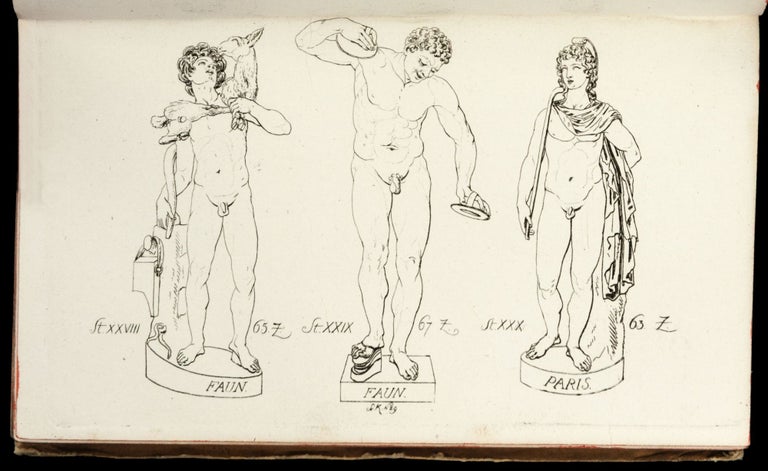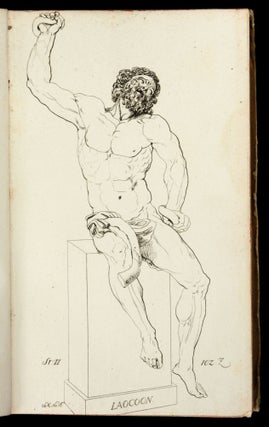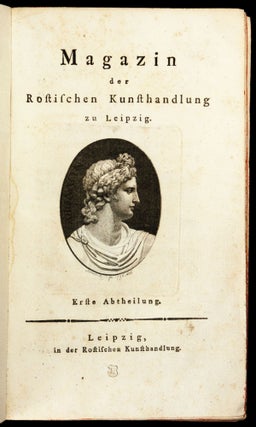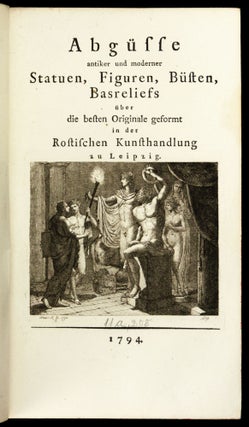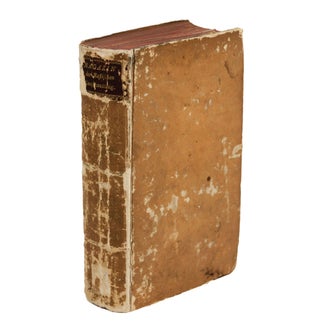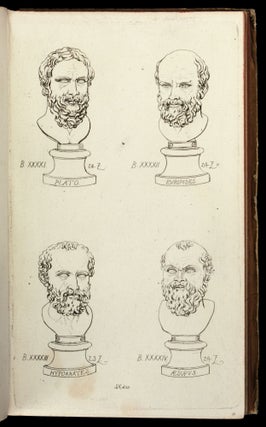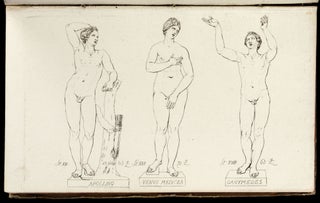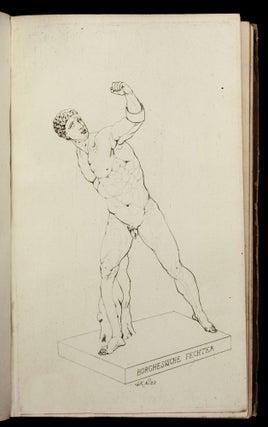Magazin der Rostischen Kunsthandlung zu Leipzig. Erste Abtheilung.
4to [21.4 x 12.9 cm], XII pp., 76 pp., with engraving on title page. [Bound with:] Magazin der Rostischen Kunsthandlung zu Leipzig. Zweite Abtheilung. Abgüsse antiker und moderner Statuen, Figuren, Büsten, Basreliefs über die besten Originale geformt in der Rostischen Kunsthandlung. Leipzig, s.n., 1794. (1) f. half-title, 71 pp., (1) p. blank verso, (1) f. engraved title, (56) full-page engravings, with engraving on title page to catalogue text (p. 1), half-page letterpress note tipped in at p 17. [And with:] Magazin der Rostischen Kunsthandlung zu Leipzig. Dritte Abtheilung. Musicalien der Rostischen Kunsthandlung zu Leipzig. Leipzig, s.n., [1796]. VIII pp., 140 pp., with engraving on title page. Bound in contemporary pasteboards, gold-stamped morocco lettering piece laid to spine, red edges. Rubbing and edge wear to spine and boards, modern bookplate inside upper cover, contemporary ownership stamp (‘Burggrafen zu Dohna Bibliothek’) on blank versos of title pages. Occasional very minor spotting, pale marginal dampstaining to text of Part 2, one plate slightly cropped; otherwise the engravings all in strong, fine strikes and well preserved; minor toning to Part 3. Set of 3 very rare 18th-century sales catalogues – unrecorded in American libraries – from the emporium of the Leipzig art dealer C. C. H. Rost (d. 1798), including his richly illustrated inventory of plaster casts made after the “best original” statues from Greco-Roman antiquity, among which are actual size reproductions of such famed pieces as the Apollo Belvedere, the Laocoön, and the Venus de’ Medici. The catalogue’s 56 full-page engravings by V. H. F. Schnorr von Carolsfeld (1764-1841) depict 54 full-scale statues, 75 busts, and numerous reduced-scale statuettes, bas-reliefs, and ‘study pieces’ all priced and available for purchase at Rost’s showroom in Auerbachs Hof. “Rost was the unchallenged market leader” (Schreiter, “Moulded,” 137) in the 18th-century trade of casts of classical sculpture and thus was a principle source for the dissemination of their reproductions throughout Germany (and beyond) during the last quarter of the 18th century. “Because of its extensive program of illustration, this impressive catalogue” – which remains an indispensable document for understanding the wider influence of such casts on burgeoning German Neoclassicism – “must be considered at least extraordinary, if not unique … In terms of comprehensiveness it exceeded any comparable work, including earlier [unillustrated] catalogues by Rost himself. Even looking through the catalogue today, one is impressed by the variety of high-quality plaster casts on offer at the time” (Schreiter, Antike, pp. 1-2). Although during the 18th-century Germany demonstrated an enthusiasm for antiquity on par with other Western European countries, it had no equivalent of the English Grand Tour, with its attendant large-scale collecting of original antiquities and verified copies from “original” sources on the Italian peninsula. While a few princely collections in Germany did possess fine original ancient statuary (e.g., Dresden) and a handful of aristocrats had access to agents in Italy who would procure for them direct casts of statues from Medici, Borghese, Ludovisi, Odescalchi and Capitoline sources (e.g., Prince Johann Wilhelm, whose casts would form the heart of the Mannheim Antikensaal), most Germans for the greater part of the 18th century knew antique statuary almost exclusively from prints and drawings. During the late 1760s and early 1770s, itinerant Italian dealers in plaster casts (e.g. the Fratelli Ferrari) provided arriviste aristocratic collectors and newly founded art academies with a certain amount of this material, but the duty of democratizing and distributing a fuller repertory of classical statuary fell to Rost, who from the early 1770s offered a streamlined service for acquiring ancient copies for academic study or domestic use. Rost here presents himself not as a mere salesman, but a patron of the fine arts who spares no effort to obtain the finest casts to offer to connoisseurs at a reasonable price (pp. 4-5). He apologizes for the cost of the catalogue but notes that the engravings were all original commissions and that, if desired, a reader could purchase just the text of the catalogue at a steep discount (p. 4; thus surviving copies of this rare work often lack the plates). Entries on individual statues discuss authorship, location, and size and often provide art historical observations. Prices are provided, and many statues were available in plaster, artificial marble, and a proprietary artificial stone called Feste Masse, which was resistant to poor weather conditions and thus appropriate for use in gardens or courtyards. Also listed are several items by modern masters (Michelangelo, Bernini, Duquesnoy, etc.). Rost orients the reader to shipping procedures and costs involved in this unusual new trade. Recent scholarship has traced the dissemination of casts from the Rost manufactory to numerous newly founded academies and public collections across Germany (see Schreiter, Antike, 431-460). The Rost Kunsthandlung dominated the cast trade in Germany until the first years of the 19th century, at which time more accurate molds became available (and were demanded by connoisseurs) both in the wake of Napoleon’s large-scale transportation of Italian artworks to Paris and with the establishment of modern art museums with their systematic collecting of direct casts of ancient and modern sculpture (the Louvre’s ‘Atelier de moulage,’ for example, was founded in 1794, in the very year that Rost published this comprehensive illustrated catalogue). Rost’s business specialized not only in statuary, but also in a wide range of etchings and engravings, paintings, drawings, luxury arts, furniture, domestic trappings, and sheet music, and the 2 further Rost catalogues in this volume (parts 1 & 3) represent valuable sources in their own right for reconstructing the art trade in late 18th-century Germany and beyond. Offered for sale (Part 1) are works by contemporary German printmakers personally known to Rost, individual engraved reproductions of Italian artworks, bound art books (e.g., on Pompeii and Herculaneum, Winkelmann’s 1767 Monumenti inediti, engravings of Hamilton’s collection of antique vases, a full range of Piranesi volumes, decorative colored views, etc.). Rost also traded in fine scientific instruments, including spyglasses, microscopes, and other optics by Gregory & Wright, Dolland, and Ramsden, the newly invented Watt copy machine, and musical instruments (the Ben Franklin glass harmonica, English pianos by Longman & Broderip, Italian violins, etc.). Through Rost, one could commission three-dimensional cork models (made in Italy) of the Colosseum, Pantheon, Arch of Constantine and more than 30 other Roman monuments or choose from a full catalogue of Wedgewood items, art supplies, interior and exterior lighting (including the newly invented Argand lamps), coffee and tea services and furniture of all sorts. Part 3 lists sheet music for some 2000 pieces available for purchase, a range of selection rarely rivaled at the time including compositions by luminaries such as Bach and Mozart, highly popular contemporary composers now rather obscure (e.g., Ignaz Pleyel [1757-1831]) and hundreds of lesser known German, French and Italian masters; there is section of ‘theoretical work,’ and the final two leaves are devoted to new music published while the catalogue was in press, including pieces by Haydn. OCLC locates no U.S. institutional copies of these 3 Rost catalogues. Other catalogues by Rost, all of which are unillustrated, are also exceedingly rare outside of Germany. * C. Schreiter, Antike um jeden Preis: Gipsabgüsse und Kopien antiker Plastik am Ende des 18. Jahrhunderts (for collation, pp. 644-7 and 667-8); C. Schreiter, “‘Moulded from the best originals of Rome’” – Eighteenth-Century Production and Trade of Plaster Casts after Antique Sculpture in Germany,” in E. Marchand and R. Frederiksen, eds., Plaster Casts: Making, Collecting and Displaying from Classical Antiquity to the Present, pp. 121-42; T. Bartsch, et al., eds., Das Originale der Kopie: Kopien als Produkte und Medien der Transformation von Antike.
Price: $11,000.00

